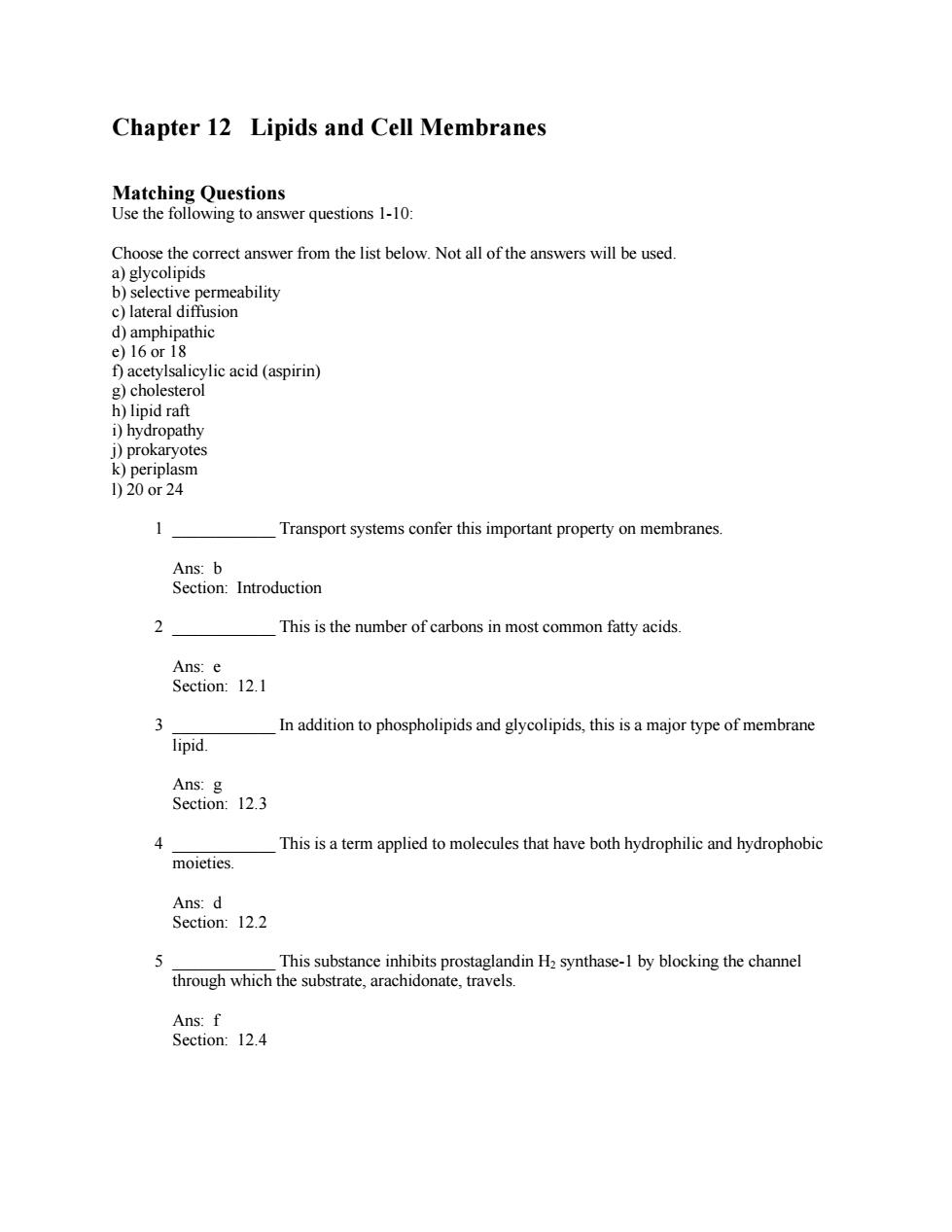
Chapter 12 Lipids and Cell Membranes Matching Questions Use the following to answer questions 1-10: Choose the correct answer from the list below.Not all of the answers will be used. a)glycolipids b)selective permeability c)lateral diffusion d)amphipathic e)16or18 f)acetylsalicylic acid (aspirin) g)cholesterol h)lipid raft i)hydropathy 1)prokaryotes k)periplasm 1)20or24 Transport systems confer this important property on membranes. Ans:b Section:Introduction 2 This is the number of carbons in most common fatty acids. Ans:e Section:12.1 In addition to phospholipids and glycolipids,this is a major type of membrane lipid Ans:g Section:12.3 This is a term applied to molecules that have both hydrophilic and hydrophobic moieties Ans:d Section:12.2 This substance inhibits prostaglandin H2 synthase-1 by blocking the channel through which the substrate,arachidonate.travels. Ans:f Section:12.4
Chapter 12 Lipids and Cell Membranes Matching Questions Use the following to answer questions 1-10: Choose the correct answer from the list below. Not all of the answers will be used. a) glycolipids b) selective permeability c) lateral diffusion d) amphipathic e) 16 or 18 f) acetylsalicylic acid (aspirin) g) cholesterol h) lipid raft i) hydropathy j) prokaryotes k) periplasm l) 20 or 24 1 ____________ Transport systems confer this important property on membranes. Ans: b Section: Introduction 2 ____________ This is the number of carbons in most common fatty acids. Ans: e Section: 12.1 3 ____________ In addition to phospholipids and glycolipids, this is a major type of membrane lipid. Ans: g Section: 12.3 4 ____________ This is a term applied to molecules that have both hydrophilic and hydrophobic moieties. Ans: d Section: 12.2 5 ____________ This substance inhibits prostaglandin H2 synthase-1 by blocking the channel through which the substrate, arachidonate, travels. Ans: f Section: 12.4
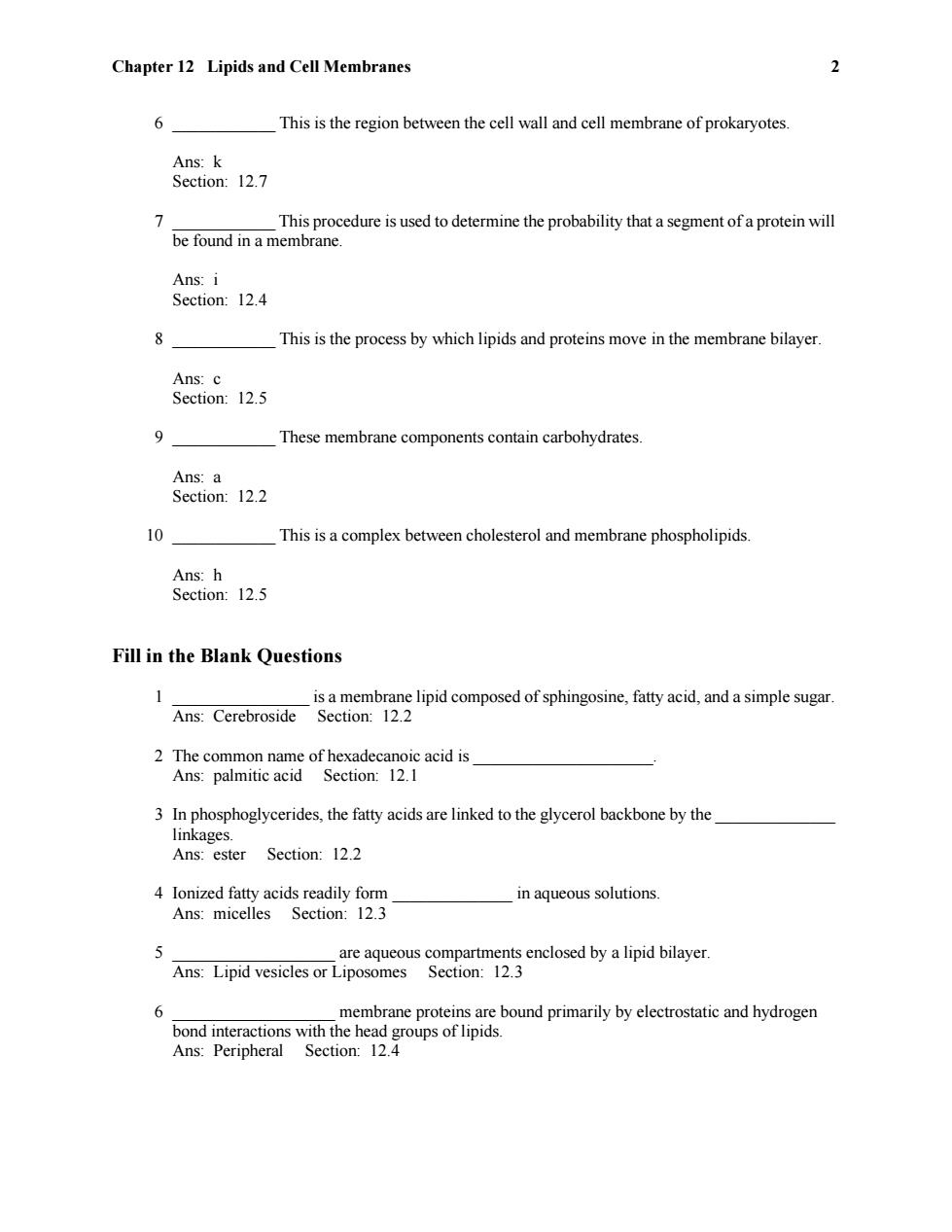
Chapter 12 Lipids and Cell Membranes 2 6 This is the region between the cell wall and cell membrane of prokaryotes. Ans:k Section:12.7 This procedure is used to determine the probability that a segment of a protein will be found in a membrane. Ans:i Section:12.4 P This is the process by which lipids and proteins move in the membrane bilayer. Ans:c Section:12.5 9 These membrane components contain carbohydrates. Ans:a Section:12.2 10 This is a complex between cholesterol and membrane phospholipids Ans:h Section:12.5 Fill in the Blank Questions 1 is a membrane lipid composed of sphingosine,fatty acid,and a simple sugar. Ans:Cerebroside Section:12.2 2 The common name of hexadecanoic acid is Ans:palmitic acid Section:12.1 3 In phosphoglycerides,the fatty acids are linked to the glycerol backbone by the linkages. Ans:ester Section:12.2 4 Ionized fatty acids readily form in aqueous solutions. Ans:micelles Section:12.3 are aqueous compartments enclosed by a lipid bilayer. Ans:Lipid vesicles or Liposomes Section:12.3 6 membrane proteins are bound primarily by electrostatic and hydrogen bond interactions with the head groups of lipids. Ans:Peripheral Section:12.4
Chapter 12 Lipids and Cell Membranes 2 6 ____________ This is the region between the cell wall and cell membrane of prokaryotes. Ans: k Section: 12.7 7 ____________ This procedure is used to determine the probability that a segment of a protein will be found in a membrane. Ans: i Section: 12.4 8 ____________ This is the process by which lipids and proteins move in the membrane bilayer. Ans: c Section: 12.5 9 ____________ These membrane components contain carbohydrates. Ans: a Section: 12.2 10 ____________ This is a complex between cholesterol and membrane phospholipids. Ans: h Section: 12.5 Fill in the Blank Questions 1 ________________ is a membrane lipid composed of sphingosine, fatty acid, and a simple sugar. Ans: Cerebroside Section: 12.2 2 The common name of hexadecanoic acid is _____________________. Ans: palmitic acid Section: 12.1 3 In phosphoglycerides, the fatty acids are linked to the glycerol backbone by the ______________ linkages. Ans: ester Section: 12.2 4 Ionized fatty acids readily form ______________ in aqueous solutions. Ans: micelles Section: 12.3 5 ___________________ are aqueous compartments enclosed by a lipid bilayer. Ans: Lipid vesicles or Liposomes Section: 12.3 6 ___________________ membrane proteins are bound primarily by electrostatic and hydrogen bond interactions with the head groups of lipids. Ans: Peripheral Section: 12.4
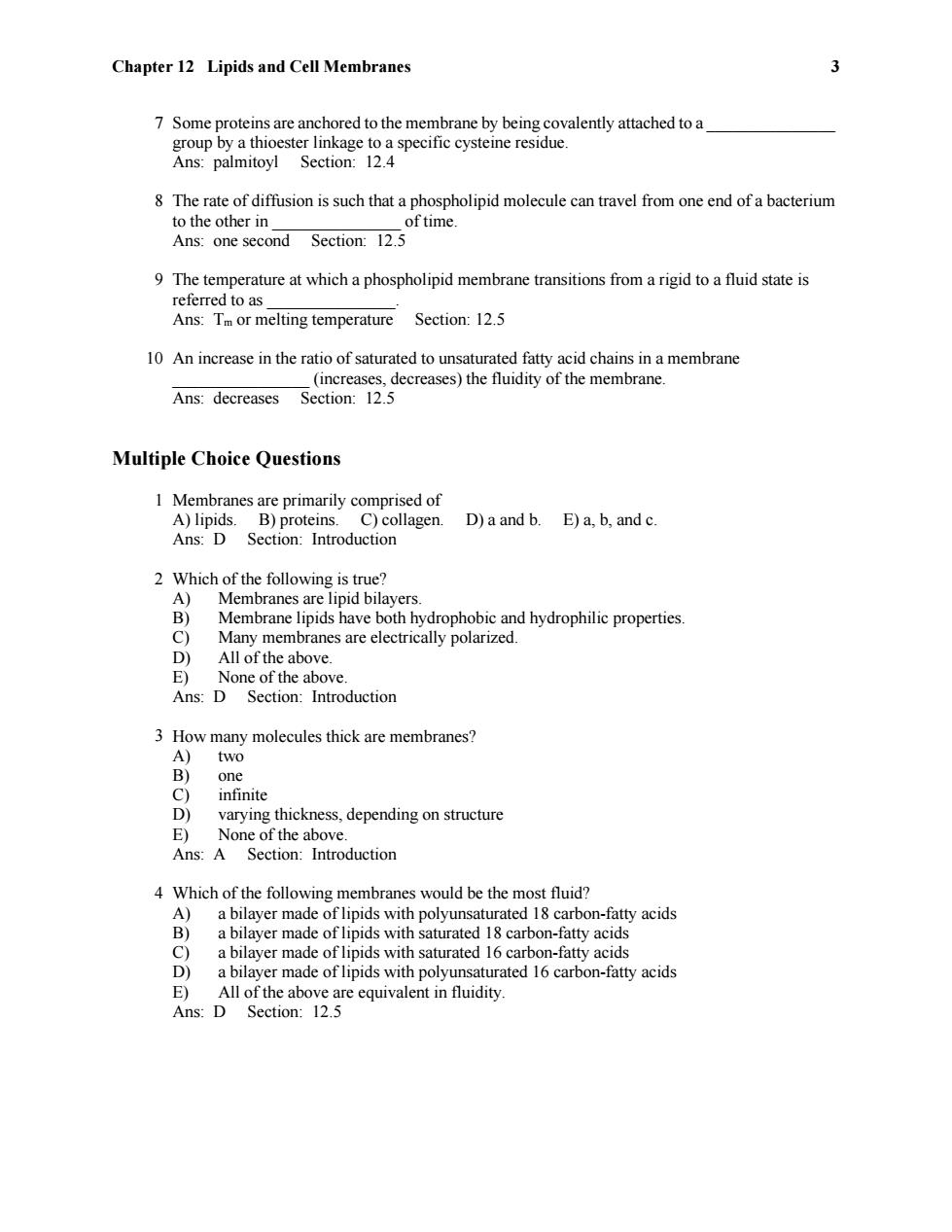
Chapter 12 Lipids and Cell Membranes 3 7 Some proteins are anchored to the membrane by being covalently attached to a group by a thioester linkage to a specific cysteine residue. Ans:palmitoyl Section:12.4 8 The rate of diffusion is such that a phospholipid molecule can travel from one end of a bacterium to the other in oftime. Ans:one second Section:12.5 9 The temperature at which a phospholipid membrane transitions from a rigid to a fluid state is referred to as Ans:Tm or melting temperature Section:12.5 10 An increase in the ratio of saturated to unsaturated fatty acid chains in a membrane (increases,decreases)the fluidity of the membrane. Ans:decreases Section:12.5 Multiple Choice Questions 1 Membranes are primarily comprised of A)lipids.B)proteins.C)collagen.D)a and b.E)a,b,and c. Ans:D Section:Introduction 2 Which of the following is true? A)Membranes are lipid bilayers. B)Membrane lipids have both hydrophobic and hydrophilic properties C) Many membranes are electrically polarized. D) All of the above. E)None of the above. Ans:D Section:Introduction 3 How many molecules thick are membranes? A) two B) one C) infinite D) varying thickness,depending on structure E)None of the above. Ans:A Section:Introduction 4 Which of the following membranes would be the most fluid? A)a bilayer made of lipids with polyunsaturated 18 carbon-fatty acids B)a bilayer made of lipids with saturated 18 carbon-fatty acids C)a bilayer made of lipids with saturated 16 carbon-fatty acids D)a bilayer made of lipids with polyunsaturated 16 carbon-fatty acids E)All of the above are equivalent in fluidity. Ans:D Section:12.5
Chapter 12 Lipids and Cell Membranes 3 7 Some proteins are anchored to the membrane by being covalently attached to a _______________ group by a thioester linkage to a specific cysteine residue. Ans: palmitoyl Section: 12.4 8 The rate of diffusion is such that a phospholipid molecule can travel from one end of a bacterium to the other in _______________ of time. Ans: one second Section: 12.5 9 The temperature at which a phospholipid membrane transitions from a rigid to a fluid state is referred to as _______________. Ans: Tm or melting temperature Section: 12.5 10 An increase in the ratio of saturated to unsaturated fatty acid chains in a membrane ________________ (increases, decreases) the fluidity of the membrane. Ans: decreases Section: 12.5 Multiple Choice Questions 1 Membranes are primarily comprised of A) lipids. B) proteins. C) collagen. D) a and b. E) a, b, and c. Ans: D Section: Introduction 2 Which of the following is true? A) Membranes are lipid bilayers. B) Membrane lipids have both hydrophobic and hydrophilic properties. C) Many membranes are electrically polarized. D) All of the above. E) None of the above. Ans: D Section: Introduction 3 How many molecules thick are membranes? A) two B) one C) infinite D) varying thickness, depending on structure E) None of the above. Ans: A Section: Introduction 4 Which of the following membranes would be the most fluid? A) a bilayer made of lipids with polyunsaturated 18 carbon-fatty acids B) a bilayer made of lipids with saturated 18 carbon-fatty acids C) a bilayer made of lipids with saturated 16 carbon-fatty acids D) a bilayer made of lipids with polyunsaturated 16 carbon-fatty acids E) All of the above are equivalent in fluidity. Ans: D Section: 12.5

Chapter 12 Lipids and Cell Membranes 4 5 Which of the following statements is consistent with the structure of biological membranes? A) All membrane proteins are integral and associate with the hydrophobic region of the membrane. B) Both proteins and lipids readily undergo transverse("flip-flop")diffusion from the inside to the outside of the membrane C) Membranes are symmetric. D) The membrane lipids self-assemble to form the lipid bilayer. E) A biological membrane consists of proteins sandwiched between two layers of lipids, which is referred to as a lipid bilayer. Ans:D Section:12.3 6 Which of the following is not correct concerning the structure given? 1 HH CH2-O-C(CH2)14CH3 CH3(CH2)C=C(CH2)C-O-CH 0 CH2-OPOCH2CH2N(CH3)3 0- A It is a component of biological membranes. B) It is amphipathic. C) It is a sphingolipid. D) It is a phosphoglyceride. E)It is phosphatidyl choline. Ans:D Section:12.2 7 How do the membranes of archaea differ from bacteria and eukaryotes? A) The lipids do not contain a carboxylic acid ester,but instead have an ether link to the glycerol. B) The alkyl chains are branched C) The stereochemistry of the central carbon of glycerol is inverted. D) a and c. E)a,b,and c. Ans:E Section:12.2 8 Carbohydrate residues attached to the membrane lipids are A)always positioned on the intracellular side of the membrane. B) always positioned on the inside center of the bilayer. C)always positioned on the extracellular side of the membrane. D) always positioned equally on both sides of the membrane. E)also covalently attached to membrane proteins Ans:C Section:12.2 9 What force(s)stabilize(s)the lipid bilayers? A)van der Waals interactions B) electrostatic and hydrogen bonding between the polar heads and surrounding water C) covalent bonds between the lipid tails D) covalent bonds between the lipids and membrane proteins E)a and b Ans:D Section:12.3
Chapter 12 Lipids and Cell Membranes 4 5 Which of the following statements is consistent with the structure of biological membranes? A) All membrane proteins are integral and associate with the hydrophobic region of the membrane. B) Both proteins and lipids readily undergo transverse (“flip-flop”) diffusion from the inside to the outside of the membrane. C) Membranes are symmetric. D) The membrane lipids self-assemble to form the lipid bilayer. E) A biological membrane consists of proteins sandwiched between two layers of lipids, which is referred to as a lipid bilayer. Ans: D Section: 12.3 6 Which of the following is not correct concerning the structure given? + C H 2 C H C H 2 O C(C H 2 )14C H 3 O C H 3 (C H 2 )7C C(C H 2 )7C O O H H O PO C H 2C H 2N (C H 3 )3 O O - A) It is a component of biological membranes. B) It is amphipathic. C) It is a sphingolipid. D) It is a phosphoglyceride. E) It is phosphatidyl choline. Ans: D Section: 12.2 7 How do the membranes of archaea differ from bacteria and eukaryotes? A) The lipids do not contain a carboxylic acid ester, but instead have an ether link to the glycerol. B) The alkyl chains are branched. C) The stereochemistry of the central carbon of glycerol is inverted. D) a and c. E) a, b, and c. Ans: E Section: 12.2 8 Carbohydrate residues attached to the membrane lipids are A) always positioned on the intracellular side of the membrane. B) always positioned on the inside center of the bilayer. C) always positioned on the extracellular side of the membrane. D) always positioned equally on both sides of the membrane. E) also covalently attached to membrane proteins. Ans: C Section: 12.2 9 What force(s) stabilize(s) the lipid bilayers? A) van der Waals interactions B) electrostatic and hydrogen bonding between the polar heads and surrounding water C) covalent bonds between the lipid tails D) covalent bonds between the lipids and membrane proteins E) a and b Ans: D Section: 12.3
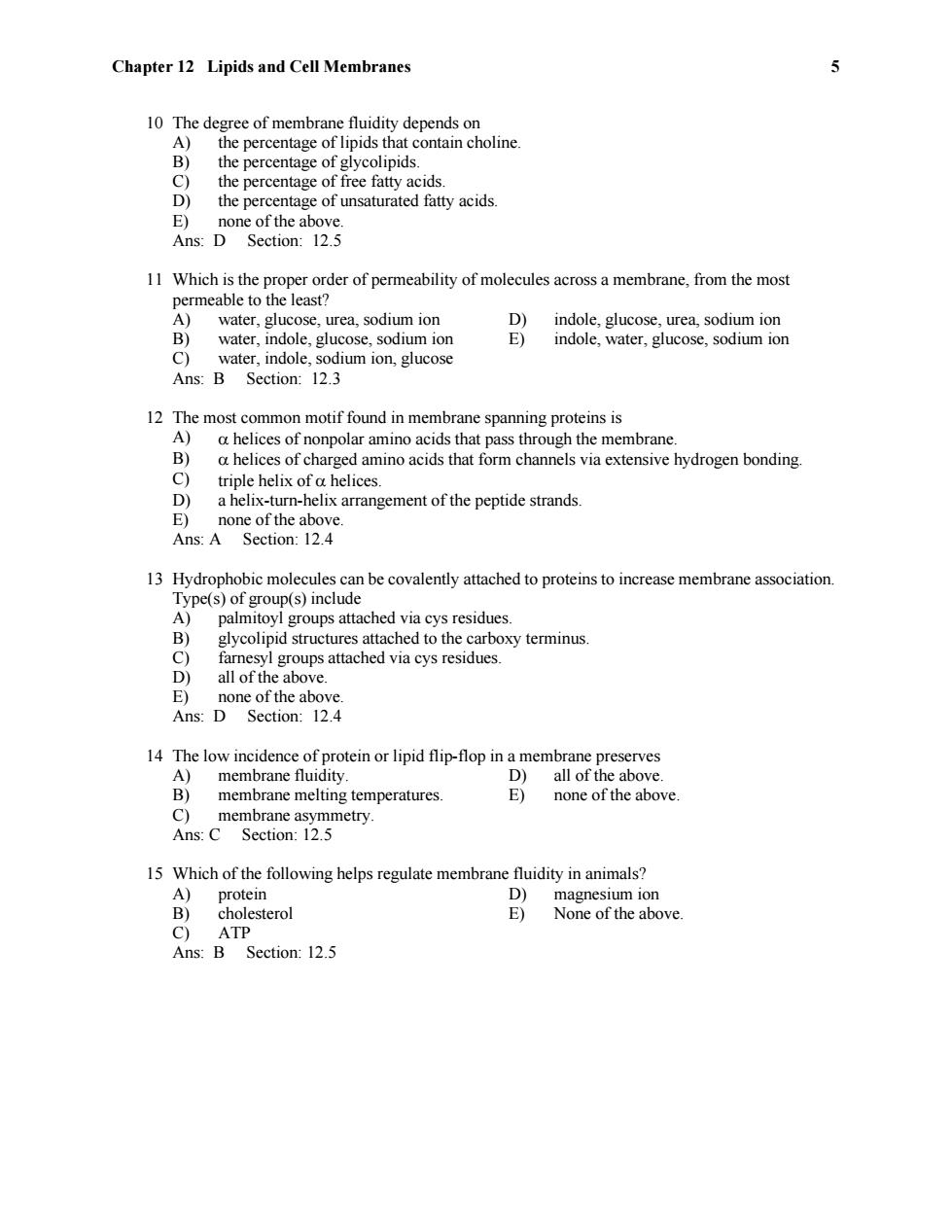
Chapter 12 Lipids and Cell Membranes 10 The degree of membrane fluidity depends on A) the percentage of lipids that contain choline. B) the percentage of glycolipids C) the percentage of free fatty acids. D) the percentage of unsaturated fatty acids. E)none of the above. Ans:D Section:12.5 11 Which is the proper order of permeability of molecules across a membrane,from the most permeable to the least? A)water,glucose,urea,sodium ion D) indole,glucose,urea,sodium ion B)water,indole,glucose,sodium ion E) indole,water,glucose,sodium ion C)water,indole,sodium ion,glucose Ans:B Section:12.3 12 The most common motif found in membrane spanning proteins is A) a helices of nonpolar amino acids that pass through the membrane. B) a helices of charged amino acids that form channels via extensive hydrogen bonding. C triple helix of a helices. D) a helix-turn-helix arrangement of the peptide strands. E) none of the above. Ans:A Section:12.4 13 Hydrophobic molecules can be covalently attached to proteins to increase membrane association. Type(s)of group(s)include A)palmitoyl groups attached via cys residues B) glycolipid structures attached to the carboxy terminus. C) farnesyl groups attached via cys residues D) all of the above. E)none of the above. Ans:D Section:12.4 14 The low incidence of protein or lipid flip-flop in a membrane preserves A)membrane fluidity. D all of the above B)membrane melting temperatures E) none of the above. C)membrane asymmetry. Ans:C Section:12.5 15 Which of the following helps regulate membrane fluidity in animals? A)protein D) magnesium ion B) cholesterol E) None of the above. C)ATP Ans:B Section:12.5
Chapter 12 Lipids and Cell Membranes 5 10 The degree of membrane fluidity depends on A) the percentage of lipids that contain choline. B) the percentage of glycolipids. C) the percentage of free fatty acids. D) the percentage of unsaturated fatty acids. E) none of the above. Ans: D Section: 12.5 11 Which is the proper order of permeability of molecules across a membrane, from the most permeable to the least? A) water, glucose, urea, sodium ion D) indole, glucose, urea, sodium ion B) water, indole, glucose, sodium ion E) indole, water, glucose, sodium ion C) water, indole, sodium ion, glucose Ans: B Section: 12.3 12 The most common motif found in membrane spanning proteins is A) helices of nonpolar amino acids that pass through the membrane. B) helices of charged amino acids that form channels via extensive hydrogen bonding. C) triple helix of helices. D) a helix-turn-helix arrangement of the peptide strands. E) none of the above. Ans: A Section: 12.4 13 Hydrophobic molecules can be covalently attached to proteins to increase membrane association. Type(s) of group(s) include A) palmitoyl groups attached via cys residues. B) glycolipid structures attached to the carboxy terminus. C) farnesyl groups attached via cys residues. D) all of the above. E) none of the above. Ans: D Section: 12.4 14 The low incidence of protein or lipid flip-flop in a membrane preserves A) membrane fluidity. D) all of the above. B) membrane melting temperatures. E) none of the above. C) membrane asymmetry. Ans: C Section: 12.5 15 Which of the following helps regulate membrane fluidity in animals? A) protein D) magnesium ion B) cholesterol E) None of the above. C) ATP Ans: B Section: 12.5

Chapter 12 Lipids and Cell Membranes 6 Short-Answer Questions 16 What does the notation 18:2 for fatty acids imply? Ans:In this fatty acid there are 18 carbons,with 2 double bonds. Section:12.1 17 What are the two systems for naming the positions of the double bonds?Provide examples. Ans:Two systems are used.One system refers to the double bond relative to the last,or omega ()carbon.(An example would be c-3 fatty acids.)The other system uses notation that indicates the position of the double bond relative to the carboxyl carbon,and indicates if the bond is cis or trans.(An example would be cis-A.) Section:12.1 18 What are some molecules that form the polar head group of a phospholipids?Provide several examples. Ans:Examples of head groups include serine,ethanolamine,choline,glycerol,and inositol. Section:12.2 19 What is cardiolipin? Ans:This is a molecule in which two phospholipids are attached through the phosphate groups to a glycerol molecule.It is also called diphosphatidyl glycerol. Section:12.2 20 Draw a cross-section of a micelle and a membrane bilayer. Ans:Micelles are spherical arrangements in which the tails are on the inside of the sphere,and the heads are on the outside surface.Bilayers have two lipid layers,in which the heads are on the outside,and the tails are arranged on the inside in two rows.Figures 12.9 and 12.10 in the textbook provide an example of this. Section:12.3 21 Draw and label a typical phospholipid Ans: The phospholipid drawn should resemble Figure 12.5 in the textbook.It should contain a central glycerol molecule,to which two fatty acids are attached in ester linkages at the center and an end.The other end should be linked to a phosphor alcohol group.The phosphate should be shown negatively charged at pH 7. HH CH2-0-C(CH2)14CH3 CH3(CH2)C=C(CH2)C-0-CH CH2-OPOCH2CH2N(CH3)3 0 Section:12.2 22 How are lipid bilayers formed?What is the driving force? Ans:Bimolecular sheets of lipids form spontaneously by self-assembly.Hydrophobic interactions are the driving force.Van der Waals attractive forces between the hydrocarbon tails favor the close packing of the tails.The polar heads are attracted to each other by electrostatic and hydrogen-bonding attractions. Section:12.4
Chapter 12 Lipids and Cell Membranes 6 Short-Answer Questions 16 What does the notation 18:2 for fatty acids imply? Ans: In this fatty acid there are 18 carbons, with 2 double bonds. Section: 12.1 17 What are the two systems for naming the positions of the double bonds? Provide examples. Ans: Two systems are used. One system refers to the double bond relative to the last, or omega (), carbon. (An example would be -3 fatty acids.) The other system uses notation that indicates the position of the double bond relative to the carboxyl carbon, and indicates if the bond is cis or trans. (An example would be cis- 9 .) Section: 12.1 18 What are some molecules that form the polar head group of a phospholipids? Provide several examples. Ans: Examples of head groups include serine, ethanolamine, choline, glycerol, and inositol. Section: 12.2 19 What is cardiolipin? Ans: This is a molecule in which two phospholipids are attached through the phosphate groups to a glycerol molecule. It is also called diphosphatidyl glycerol. Section: 12.2 20 Draw a cross-section of a micelle and a membrane bilayer. Ans: Micelles are spherical arrangements in which the tails are on the inside of the sphere, and the heads are on the outside surface. Bilayers have two lipid layers, in which the heads are on the outside, and the tails are arranged on the inside in two rows. Figures 12.9 and 12.10 in the textbook provide an example of this. Section: 12.3 21 Draw and label a typical phospholipid. Ans: The phospholipid drawn should resemble Figure 12.5 in the textbook. It should contain a central glycerol molecule, to which two fatty acids are attached in ester linkages at the center and an end. The other end should be linked to a phosphor alcohol group. The phosphate should be shown negatively charged at pH 7. + C H 2 C H C H 2 O C(C H 2 )14C H 3 O C H 3 (C H 2 )7C C(C H 2 )7C O O H H O PO C H 2C H 2N (C H 3 )3 O O - Section: 12.2 22 How are lipid bilayers formed? What is the driving force? Ans: Bimolecular sheets of lipids form spontaneously by self-assembly. Hydrophobic interactions are the driving force. Van der Waals attractive forces between the hydrocarbon tails favor the close packing of the tails. The polar heads are attracted to each other by electrostatic and hydrogen-bonding attractions. Section: 12.4
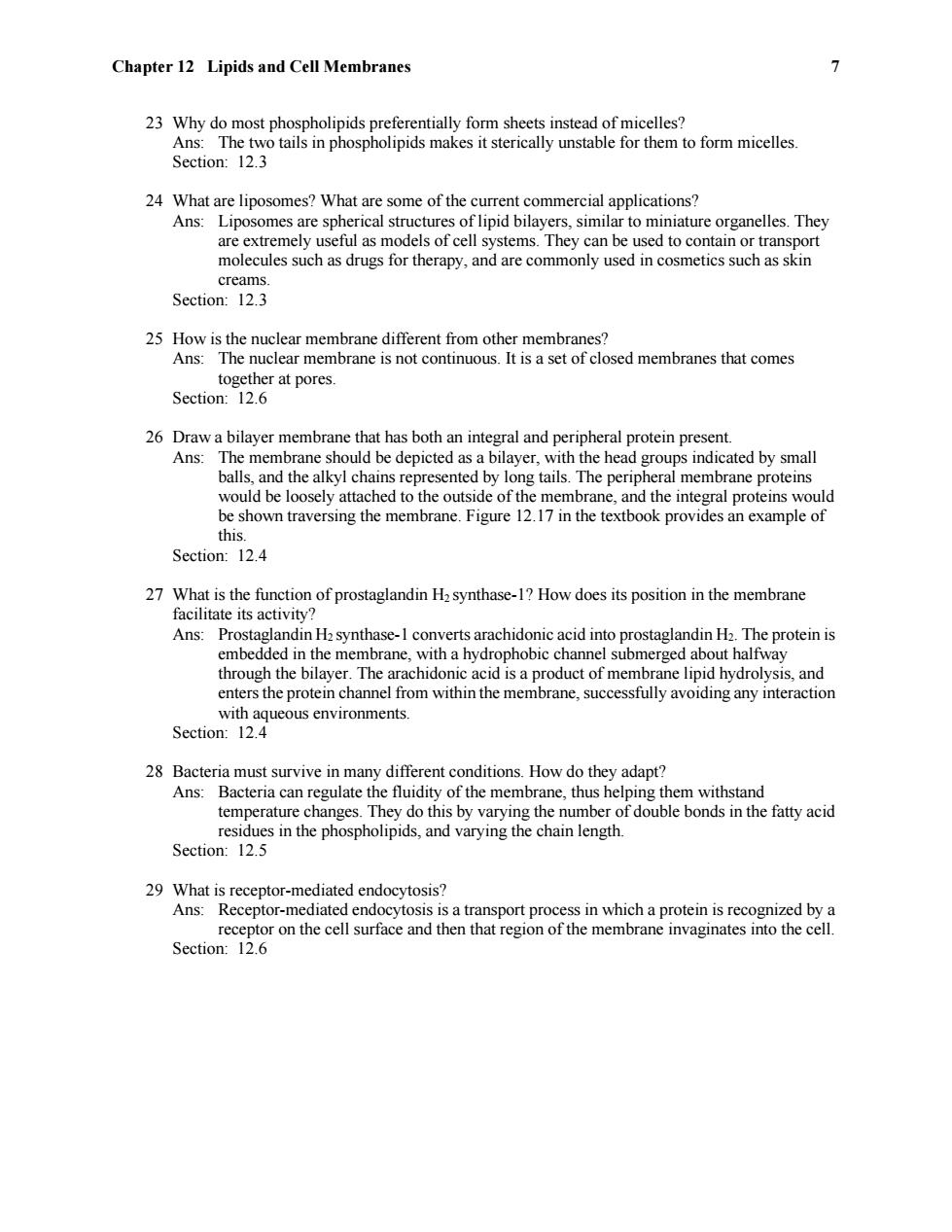
Chapter 12 Lipids and Cell Membranes 7 23 Why do most phospholipids preferentially form sheets instead of micelles? Ans:The two tails in phospholipids makes it sterically unstable for them to form micelles. Section:12.3 24 What are liposomes?What are some of the current commercial applications? Ans:Liposomes are spherical structures of lipid bilayers,similar to miniature organelles.They are extremely useful as models of cell systems.They can be used to contain or transport molecules such as drugs for therapy,and are commonly used in cosmetics such as skin creams Section:12.3 25 How is the nuclear membrane different from other membranes? Ans:The nuclear membrane is not continuous.It is a set of closed membranes that comes together at pores. Section:12.6 26 Draw a bilayer membrane that has both an integral and peripheral protein present. Ans:The membrane should be depicted as a bilayer,with the head groups indicated by small balls,and the alkyl chains represented by long tails.The peripheral membrane proteins would be loosely attached to the outside of the membrane,and the integral proteins would be shown traversing the membrane.Figure 12.17 in the textbook provides an example of this. Section:12.4 27 What is the function of prostaglandin H2 synthase-1?How does its position in the membrane facilitate its activity? Ans:Prostaglandin H2 synthase-1 converts arachidonic acid into prostaglandin H2.The protein is embedded in the membrane,with a hydrophobic channel submerged about halfway through the bilayer.The arachidonic acid is a product of membrane lipid hydrolysis,and enters the protein channel from within the membrane,successfully avoiding any interaction with aqueous environments. Section:12.4 28 Bacteria must survive in many different conditions.How do they adapt? Ans:Bacteria can regulate the fluidity of the membrane,thus helping them withstand temperature changes.They do this by varying the number of double bonds in the fatty acid residues in the phospholipids,and varying the chain length. Section:12.5 29 What is receptor-mediated endocytosis? Ans:Receptor-mediated endocytosis is a transport process in which a protein is recognized by a receptor on the cell surface and then that region of the membrane invaginates into the cell. Section:12.6
Chapter 12 Lipids and Cell Membranes 7 23 Why do most phospholipids preferentially form sheets instead of micelles? Ans: The two tails in phospholipids makes it sterically unstable for them to form micelles. Section: 12.3 24 What are liposomes? What are some of the current commercial applications? Ans: Liposomes are spherical structures of lipid bilayers, similar to miniature organelles. They are extremely useful as models of cell systems. They can be used to contain or transport molecules such as drugs for therapy, and are commonly used in cosmetics such as skin creams. Section: 12.3 25 How is the nuclear membrane different from other membranes? Ans: The nuclear membrane is not continuous. It is a set of closed membranes that comes together at pores. Section: 12.6 26 Draw a bilayer membrane that has both an integral and peripheral protein present. Ans: The membrane should be depicted as a bilayer, with the head groups indicated by small balls, and the alkyl chains represented by long tails. The peripheral membrane proteins would be loosely attached to the outside of the membrane, and the integral proteins would be shown traversing the membrane. Figure 12.17 in the textbook provides an example of this. Section: 12.4 27 What is the function of prostaglandin H2 synthase-1? How does its position in the membrane facilitate its activity? Ans: Prostaglandin H2 synthase-1 converts arachidonic acid into prostaglandin H2. The protein is embedded in the membrane, with a hydrophobic channel submerged about halfway through the bilayer. The arachidonic acid is a product of membrane lipid hydrolysis, and enters the protein channel from within the membrane, successfully avoiding any interaction with aqueous environments. Section: 12.4 28 Bacteria must survive in many different conditions. How do they adapt? Ans: Bacteria can regulate the fluidity of the membrane, thus helping them withstand temperature changes. They do this by varying the number of double bonds in the fatty acid residues in the phospholipids, and varying the chain length. Section: 12.5 29 What is receptor-mediated endocytosis? Ans: Receptor-mediated endocytosis is a transport process in which a protein is recognized by a receptor on the cell surface and then that region of the membrane invaginates into the cell. Section: 12.6
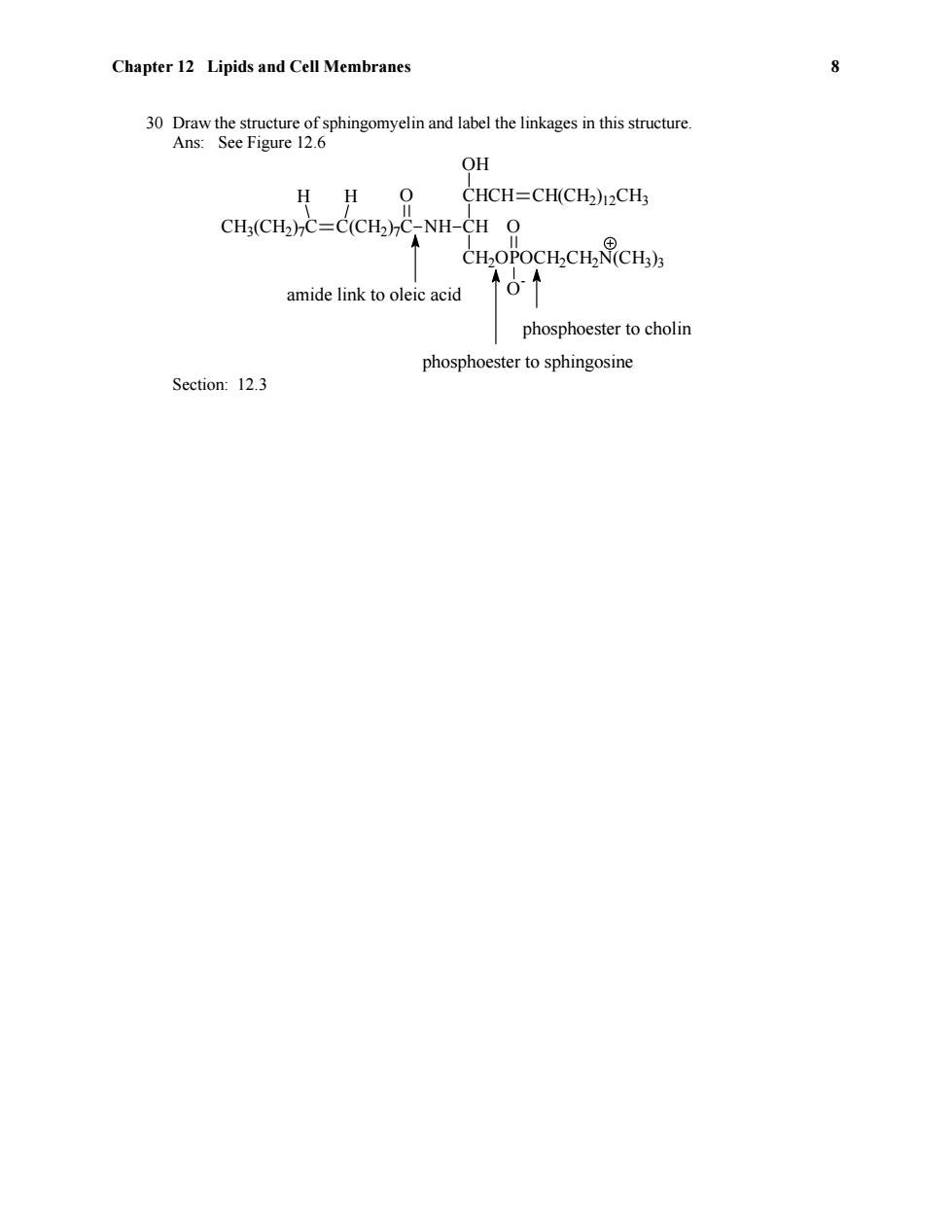
Chapter 12 Lipids and Cell Membranes 8 30 Draw the structure of sphingomyelin and label the linkages in this structure. Ans:See Figure 12.6 OH H CHCH=CH(CH)12CH3 CH:(CH2)C=C(CH2)C-NH-CH O CH2OPOCH2CH2N(CH3)3 amide link to oleic acid phosphoester to cholin phosphoester to sphingosine Section:12.3
Chapter 12 Lipids and Cell Membranes 8 30 Draw the structure of sphingomyelin and label the linkages in this structure. Ans: See Figure 12.6 CH3 (CH2 )7C C(CH2 )7C H H O NH CH CH2OPOCH2CH2N(CH3 )3 O O - CHCH CH(CH2 )12CH3 OH amide link to oleic acid phosphoester to choline phosphoester to sphingosine Section: 12.3